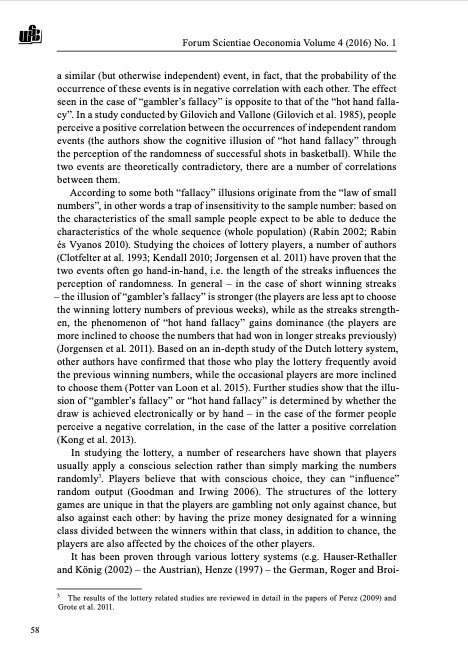
PDF Publication Title:
Text from PDF Page: 004
Forum Scientiae Oeconomia Volume 4 (2016) No. 1 a similar (but otherwise independent) event, in fact, that the probability of the occurrence of these events is in negative correlation with each other. The effect seen in the case of “gambler’s fallacy” is opposite to that of the “hot hand falla- cy”. In a study conducted by Gilovich and Vallone (Gilovich et al. 1985), people perceive a positive correlation between the occurrences of independent random events (the authors show the cognitive illusion of “hot hand fallacy” through the perception of the randomness of successful shots in basketball). While the two events are theoretically contradictory, there are a number of correlations between them. According to some both “fallacy” illusions originate from the “law of small numbers”, in other words a trap of insensitivity to the sample number: based on the characteristics of the small sample people expect to be able to deduce the characteristics of the whole sequence (whole population) (Rabin 2002; Rabin és Vyanos 2010). Studying the choices of lottery players, a number of authors (Clotfelter at al. 1993; Kendall 2010; Jorgensen et al. 2011) have proven that the two events often go hand-in-hand, i.e. the length of the streaks influences the perception of randomness. In general – in the case of short winning streaks – the illusion of “gambler’s fallacy” is stronger (the players are less apt to choose the winning lottery numbers of previous weeks), while as the streaks strength- en, the phenomenon of “hot hand fallacy” gains dominance (the players are more inclined to choose the numbers that had won in longer streaks previously) (Jorgensen et al. 2011). Based on an in-depth study of the Dutch lottery system, other authors have confirmed that those who play the lottery frequently avoid the previous winning numbers, while the occasional players are more inclined to choose them (Potter van Loon et al. 2015). Further studies show that the illu- sion of “gambler’s fallacy” or “hot hand fallacy” is determined by whether the draw is achieved electronically or by hand – in the case of the former people perceive a negative correlation, in the case of the latter a positive correlation (Kong et al. 2013). In studying the lottery, a number of researchers have shown that players usually apply a conscious selection rather than simply marking the numbers randomly3. Players believe that with conscious choice, they can “influence” random output (Goodman and Irwing 2006). The structures of the lottery games are unique in that the players are gambling not only against chance, but also against each other: by having the prize money designated for a winning class divided between the winners within that class, in addition to chance, the players are also affected by the choices of the other players. It has been proven through various lottery systems (e.g. Hauser-Rethaller and König (2002) – the Austrian), Henze (1997) – the German, Roger and Broi- 3 The results of the lottery related studies are reviewed in detail in the papers of Perez (2009) and Grote et al. 2011. 58PDF Image | PATTERNS IN THE LOTTERY GAME

PDF Search Title:
PATTERNS IN THE LOTTERY GAMEOriginal File Name Searched:
kwartalnik-1-2016-5.pdfDIY PDF Search: Google It | Yahoo | Bing
Cruise Ship Reviews | Luxury Resort | Jet | Yacht | and Travel Tech More Info
Cruising Review Topics and Articles More Info
Software based on Filemaker for the travel industry More Info
The Burgenstock Resort: Reviews on CruisingReview website... More Info
Resort Reviews: World Class resorts... More Info
The Riffelalp Resort: Reviews on CruisingReview website... More Info
| CONTACT TEL: 608-238-6001 Email: greg@cruisingreview.com | RSS | AMP |